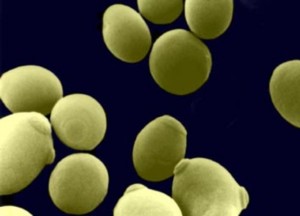Enter your address to receive notifications about new posts to your email.
Articles tagged Fungi
(21 results)
-
An extra chromosome that does double duty
Inheriting an extra chromosome can sometimes be disastrous, but in the September issue of G3, Linder et al. investigate a chromosome duplication that helps yeast survive harsh conditions. Yeast with an extra copy of chromosome IV better tolerate hydrogen peroxide exposure, largely thanks to an extra copy of a gene that detoxifies the chemical. This…
-
Switching biofilm formation on and off in yeast
When a group of microorganisms needs to stick together, they build a biofilm. The cells cement themselves together onto a surface, forming durable structures that are notoriously hard to remove. In a medical setting, biofilms can contribute to dangerous antibiotic resistance. In the August issue of G3, Cromie et al. use a yeast model to…
-
The push-and-pull evolution of tandem-duplicated drug-resistance genes
Two highly similar genes that contribute to drug resistance in a pathogenic yeast have been co-evolving as tandem duplicates for the past 134 million years—while maintaining distinct functions. This is the conclusion of a paper in the April issue of GENETICS by Lamping et al. that examines the evolutionary effects of ectopic gene conversion. Evolutionary…
-
Pathogenic yeast uniquely resists toxicity of aggregation-prone proteins
Misfolded proteins can be so toxic that they cause cell death. At least nine neurodegenerative disorders are caused by misfolded proteins with expanded stretches of glutamine residues (polyQ tracts), including the invariably fatal Huntington’s disease. But some organisms are resistant to the harmful effects of these proteins. In the January issue of G3, Leach et…
-
Cold-loving fungi fight frostbite, but can’t take the heat
To the unaided eye, Antarctic soil and alpine glaciers may appear to be barren wastelands devoid of life. But some microbes call hostile habitats like these home. Research on one such organism, published in the latest issue of G3, reveals some of the mechanisms behind cold adaptation—and explains why these otherwise hardy creatures can’t survive…
-
GSA-Art: Matthew Sachs
GSA-Art features the creative works of scientists. Read more in GSA President Stan Fields’ call for submissions. If you would like to submit your own work or nominate someone else’s, please send an email to GenesToGenomes@genetics-gsa.org with “GSA-Art” in the subject line. Our first GSA-Art post is by Matthew S. Sachs, a Professor in the Department of Biology at Texas A&M University…
-
Fungal signaling illuminated by undergrad researchers
Versatile and ubiquitous, G-protein coupled receptors (GPCRs) are the busybodies of eukaryotic signaling. This diverse group of stimulus-sensing membrane proteins are involved in countless aspects of growth, development, immunity, metabolism, and response to environmental conditions. In the latest issue of G3, Cabrera et al. report phenotypic and gene expression data for more than 80% of…
-
Frog fungus gets lazy in the lab
Amphibians around the world have been devastated by the spread of the deadly fungus Batrachochytrium dendrobatidis (Bd). But although many populations have been decimated, others have survived the same threat. One reason for such different outcomes is variation in virulence between Bd isolates. In the latest issue of G3, Refsnider and Poorten et al. investigate…
-
New Faculty Profile: Meleah Hickman
New Faculty Profiles showcase GSA members who are establishing their first independent labs. If you’d like to be considered for a profile, please complete this form on the GSA website. Meleah Hickman Assistant Professor, Department of Biology (since 2014) Emory University Lab website @meleahhickman Research program: My lab investigates how eukaryotic pathogens generate…
-
Sex with Benefits: Candida albicans and the Selective Advantage of Mating
A vast number of species depend on sexual reproduction for survival. Sex facilitates adaptation and rids populations of deleterious mutations. Despite the benefits of this process, sex can be remarkably costly and disrupt already advantageous genetic combinations. Only 20% of fungal species have been observed to reproduce sexually, and a long-standing mystery for researchers is…

![Photo by publicdomainpictures.net. [CC0]](https://s36063.pcdn.co/wp-content/uploads/2017/09/red-doubledecker_770x-300x199.jpg)



![By 23am.com (Antarctica Sailing Trip) [CC BY 2.0], via Wikimedia Commons.](https://s36063.pcdn.co/wp-content/uploads/2016/11/rsz_1antarctica_sailing_trip_pct283253678755pct29-300x201.jpg)




